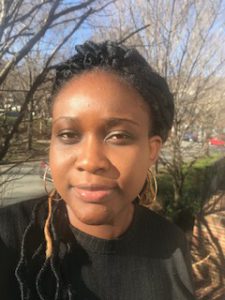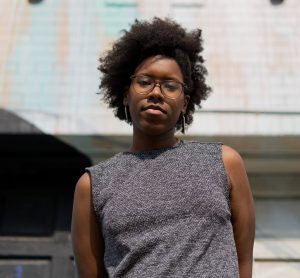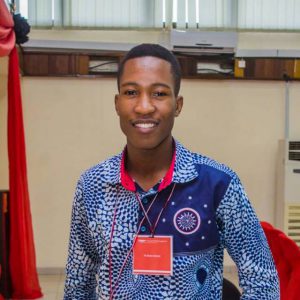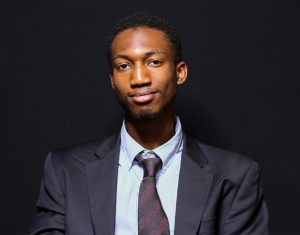A team of four students from the University of Baltimore were announced as winners of the University System of Maryland’s COVID App Challenge competition, led by the USM COVID Research & Innovation Task Force. Participating teams were challenged to develop a mobile application solution that could help bring Marylanders together to more effectively respond to COVID-19 and future pandemics. Six winning teams were selected, each earning a cash prize of $3,000.
UB’s team, known as Team Breeze—Olubukola Akanbi, Charles Chase, Stephanie Parey and Michael Vandi—developed a COVID-19 Information and Tracker (CIAT) application that uses Bluetooth technology to track users’ locations in order to limit the spread of COVID-19 and to give them important information and updates regarding their specific location.
“The app has a map feature that is useful for displaying cases of COVID-19 infection rates in all postal codes and cities in Maryland,” said Olubukola, an Information and Interaction Design doctoral student at UB. “Having the right perspective on the infection rates per location can reduce fear and anxiety associated with COVID-19 and help those living in highly infected areas to be more cautious.”
When asked why they wanted to participate in this effort to make an app related to COVID-19, all four team members agreed that they saw it as a way to contribute something useful to the fight against COVID-19.
“I had been wanting to do more to help communities cope with COVID-19 but within my specific field,” said Parey, an Interaction Design and Information Architecture graduate student. “I jumped at this opportunity because I knew that we could create something extremely useful in these uncertain times.”
The students collaborated remotely, and each team member had different responsibilities, including user experience research and design, data analysis, usability testing, design layout, interface design and programming.
“When I heard current contact tracing apps developed by huge tech companies sacrifice users’ privacy by tracking our location, I knew there had to be a better way,” Vandi, a student in the Applied Information Technology undergraduate program, noted. “I joined the team because I wanted to show that contact tracing and protecting user’s privacy can be done simultaneously.”
The team was brought together by Giovanni Vincenti, associate professor in the Division of Science, Information Arts and Technologies.
“I forwarded the call for proposals from USM to all of the programs within our division, and four students responded,” Prof. Vincenti said. “I introduced them to each other, and they did the rest.”
The UB team had less than a month to develop and submit their concept. Entries were to include a 3-minute demonstration video that shows the app and how it functions, and a presentation that explains the app’s usefulness. Judges, who included members of the USM community, tech corporations and local companies, and entrepreneurial advisors from across the USM, evaluated entries based on functionality and feasibility, innovation and impact. The UB team’s competitive entry earned them one of six cash prizes.
“One of the reasons I joined the app challenge was that I saw an opportunity to use my skills to help people firsthand,” said Chase, a Simulation and Game Design major. “I hope the CIAT app continues to support people during this critical time.”
Download the CIAT app. Learn more about the USM COVID App Challenge.
Q&A with Associate Professor Giovanni Vincenti
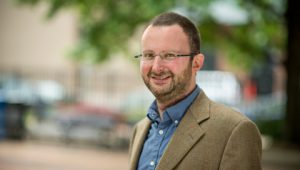
Giovanni Vincenti is an associate professor in the Division of Science, Information Arts and Technologies and director of the B.S. in Applied Information Technology program.
Giovanni Vincenti, associate professor and director of the Applied Information Technology program in the University of Baltimore’s Division of Science, Information Arts and Technologies (SIAT), serves as a mentor and guide to many students in this growing field, including the four students who entered the recent University System of Maryland’s COVID App Challenge, a contest to develop a piece of technology that could be useful during the ongoing pandemic. Prof. Vincenti spoke about the four, who went by the name Team Breeze, in a recent interview. His responses, edited for length, are as follows:
Given the challenges of working remotely, how were the students able to put together their entry?
They met as necessary online and exchanged the documentation and/or products for which each team member was responsible.
What kind of support and guidance did you and others in the program provide to them as they built the app?
Christine Spencer, the dean of our Yale Gordon College of Arts and Sciences, forwarded to all the students in the college the call for proposals and the applications from the USM. I sent it along to those students who are majoring in SIAT, letting them know that, if someone was interested and looking for peers, they should let me know. Four students — Olubukola Akanbi, Charles Chase, Stephanie Parey, and Michael Vandi — responded, one from each of our technical majors. I introduced them to each other and they did the rest.
I credit our applied, hands-on programs as the providers of the experience necessary to assemble this project in one month. Their hard work and discipline were paramount, and the technical skills they learned in our courses gave them solid foundations. They asked a few questions regarding concepts, but they tackled nearly the entire project on their own. I just played matchmaker!
Will the team receive academic credit for this work? Or did they take on the challenge simply because they knew they could?
They did it because they wanted to help, and they took it on because they can. It’s another tangible example of what our students can produce in a relatively short time, working remotely, and with other adult responsibilities like families, jobs, internships, and so on, during a pandemic.
From your perspective, what does it say about these students that they stepped up and completed the app?
Our students are not afraid to start making a change in the world with the skills they are developing at UB. They are constantly presented with challenges, and this time it happens to be one that was part of a competition. Other than that, many of our courses involve some type of “real-life experience,” such as real customers in IDIA/IID, NASA SUITS for AIT/SGD/IDIA, and several gaming projects for SGD. Michael Vandi was also part of the AstroBees and will likely continue as that team’s lead programmer next year.
How does a project like this add to a student’s understanding of technology and its application in a changing world?
They realize that implementing solutions to projects is much more involved than it sounds, and also that the fundamentals that they learn in the classroom can make a difference, today, in their lives and the lives of others. We do not teach the technologies that they used or the context in which their app will operate, but they were able to take skills and techniques and transpose them to a new project, with unusual requirements — we haven’t had a pandemic in a while! Also, they worked with people they did not know at all. None of them knew each other before their work began.
Did a student say anything to you about this challenge that you found inspiring or insightful?
They were all very thankful for the opportunity and the connection. Even though they did it all themselves, I believe they knew that they could count on our faculty and me if they had any issues or questions.
From the day they entered the competition, I saw it as our students once again doing a fantastic job. I introduced them to each other, answered the few questions they had, and they were into it. The concept, implementation, and testing – all of that success is theirs. For me, their efforts really show how complementary all of our programs are. Now that they’ve won, it’s another reason to be very proud of our students.

